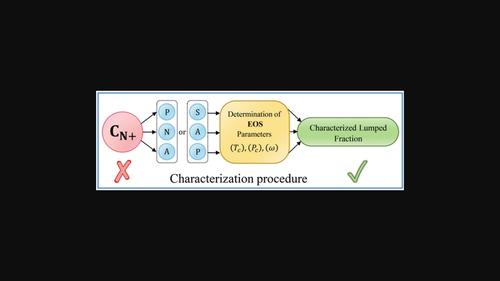当前位置:
X-MOL 学术
›
Can. J. Chem. Eng.
›
论文详情
Our official English website, www.x-mol.net, welcomes your
feedback! (Note: you will need to create a separate account there.)
An effective characterization procedure for petroleum reservoir fluids using molecular type methods and cubic equations of state
The Canadian Journal of Chemical Engineering ( IF 1.6 ) Pub Date : 2022-07-24 , DOI: 10.1002/cjce.24567 Pouya Hosseinifar 1 , Hamidreza Shahverdi 1
The Canadian Journal of Chemical Engineering ( IF 1.6 ) Pub Date : 2022-07-24 , DOI: 10.1002/cjce.24567 Pouya Hosseinifar 1 , Hamidreza Shahverdi 1
Affiliation

|
Two eminent molecular type composition methods (paraffins, naphthenes, and aromatics [PNA] and saturates, aromatics, and polynuclear aromatics [SAP]) are employed to construct new characterization procedures for predicting the phase behaviour of petroleum fluids using a modified Peng–Robinson equation of state. The PNA and SAP methods divide a petroleum fraction into (PNA) and (SAP) homologous groups, respectively. Two generalized models are developed to predict the physical properties (
中文翻译:

使用分子类型方法和三次状态方程对石油储层流体进行有效表征的程序
采用两种著名的分子类型组成方法(链烷烃、环烷烃和芳烃 [PNA] 和饱和烃、芳烃和多核芳烃 [SAP])构建新的表征程序,使用改进的 Peng-Robinson 方程预测石油流体的相行为状态。PNA 和 SAP 方法将石油馏分分别分为 (PNA) 和 (SAP) 同源组。开发了两个广义模型来预测物理特性(
更新日期:2022-07-24
中文翻译:

使用分子类型方法和三次状态方程对石油储层流体进行有效表征的程序
采用两种著名的分子类型组成方法(链烷烃、环烷烃和芳烃 [PNA] 和饱和烃、芳烃和多核芳烃 [SAP])构建新的表征程序,使用改进的 Peng-Robinson 方程预测石油流体的相行为状态。PNA 和 SAP 方法将石油馏分分别分为 (PNA) 和 (SAP) 同源组。开发了两个广义模型来预测物理特性(









































 京公网安备 11010802027423号
京公网安备 11010802027423号